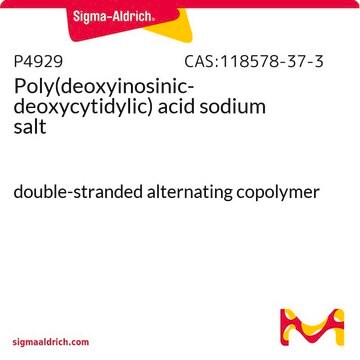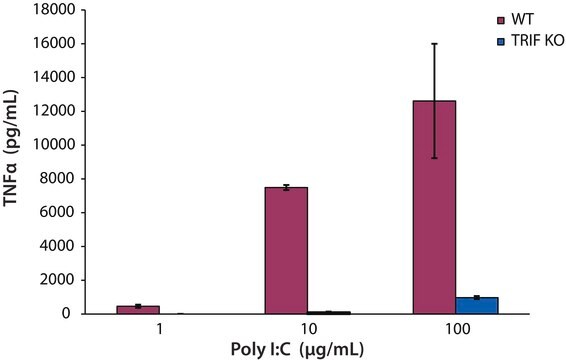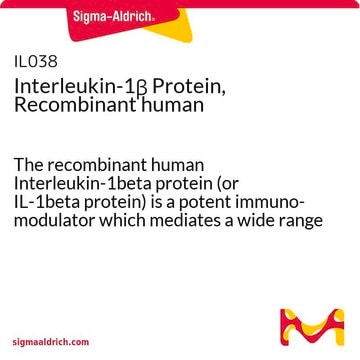추천 제품
Grade
Molecular Biology
Quality Level
양식
powder
품질
lyophilized
분자량
Mr ~2.5 × 106 (broad molecular weight distribution)
Mr ~2500000
포장
ampule of ≥10 units A260
저장 온도
−20°C
일반 설명
Poly (2′-deoxyinosinic-2′-deoxycytidylic acid) sodium salt is an alternating copolymer that acts as a substrate for DNA methyltransferases.
애플리케이션
Poly(2′-deoxyinosinic-2′-deoxycytidylic acid) sodium salt has been used in electrophoretic mobility shift assay (EMSA) of the transcription factor AP-2 Alpha (TFAP2A) and in southwestern blotting of human embryonic kidney cells (HEK293) nuclear extract.
Suitable for
- non-specific blocking agent in EMSA
- evaluation of DNA methyltransferases
- DNA-small molecule or drug interaction studies
생화학적/생리학적 작용
Poly(2′-deoxyinosinic-2′-deoxycytidylic acid), poly(dI-dC) is a synthetic DNA substrate. At high salt, Poly(dI-dC) exists in left handed helical conformation and reverts to right-handed form upon decreasing salt. It is used as a non-specific competitor in electrophoretic mobility shift assay (EMSA).
Storage Class Code
11 - Combustible Solids
WGK
WGK 3
Flash Point (°F)
Not applicable
Flash Point (°C)
Not applicable
개인 보호 장비
Eyeshields, Gloves, type N95 (US)
Repeated probing of Southwestern blots using alkaline phosphatase stripping
Jia Y, et al.
Journal of Chromatography A, 1217(45), 7177-7181 (2010)
TFAP2A is a component of the ZEB1/2 network that regulates TGFB1-induced epithelial to mesenchymal transition
Dimitrova Y, et al.
Biology Direct, 12(1), 8-8 (2017)
An enzymatic method for the determination of dCTP and dGTP in picomole amounts.
L Skoog
European journal of biochemistry, 17(2), 202-208 (1970-12-01)
Optimization of Competitor Poly (dI-dC) Poly (dI-dC) Levels is Advised in DNA-Protein Interaction Studies Involving Enriched Nuclear Proteins
Larouche K, et al.
Biotechniques, 20(3), 439-444 (1996)
Xiaomei Xu et al.
eLife, 9 (2020-08-09)
Local activation and long-range inhibition are mechanisms conserved in self-organizing systems leading to biological patterns. A number of them involve the production by the developing cell of an inhibitory morphogen, but how this cell becomes immune to self-inhibition is rather
자사의 과학자팀은 생명 과학, 재료 과학, 화학 합성, 크로마토그래피, 분석 및 기타 많은 영역을 포함한 모든 과학 분야에 경험이 있습니다..
고객지원팀으로 연락바랍니다.
![Poly[d(I-C)] lyophilized, pkg of 10 U (10108812001 [A<sub>260</sub> units]), pkg of 50 U (11219847001 [A<sub>260</sub> units])](/deepweb/assets/sigmaaldrich/product/images/352/091/ef743cea-ccd8-44f1-8f3b-dec5a1e4f5d1/640/ef743cea-ccd8-44f1-8f3b-dec5a1e4f5d1.jpg)







